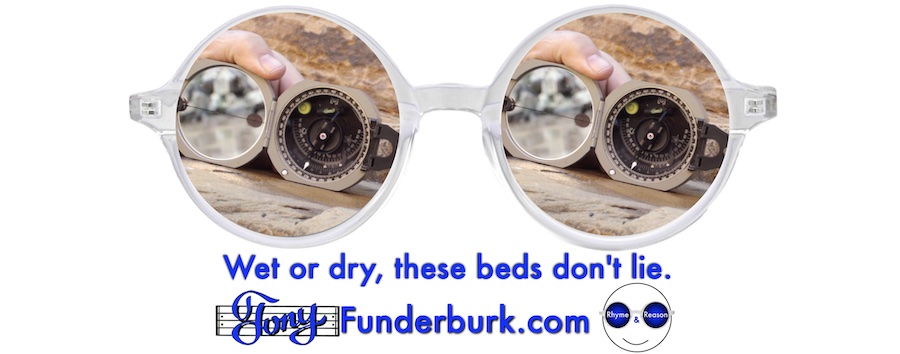Would you believe, in all my criss-cross traveling days as a professional musician, I never visited the Grand Canyon. Nope. I still haven’t seen it up close and personal. And I just read an article, and watched some videos, that piqued my interest to go see that big hole in the ground. Because of the fascinating information about cross-beds. That’s why I titled this post “wet or dry, these beds don’t lie.” It’ll make more sense shortly.
Wet or dry refers to the methodology in the videos.
And before I go any further, let me say, I gotta get a cool Brunton geology compass. Dr. John Whitmore, the guy in the video I’ll share with you, is the senior geology professor at Cedarville University. And he shows how he uses the Brunton compass to measure slope in the Coconino Sandstone cross-beds.
I love science when it’s actual science and not an anti God religion of blind faith. So, I enjoy information where actual scientists show actual rock formations and what’s actually going on. Or I should say what actually went on, back in the past.
Anyway…
Dr. Whitmore takes future and wannabe creation scientists on field trips down the Colorado River into the Grand Canyon. And he’s become a hands-on expert when it comes to the Coconino Sandstone cross-beds. I love how the article I read called out “conventional scientists,” and then said, they “have long considered this sandstone layer to be an example of an ancient desert filled with sand dunes. The technical term is eolian, or wind-blown, sandstone.”
But Dr. Whitmore believes something else explains the cross-beds.
And he shares a lot of evidence for the Coconino to be “a massive underwater sand deposit, or marine sandstone.” And that evidence points to something that makes total sense. Something I’ve talked about many times here on my website and in person with people who care to talk about it.
A global flood.
Before I read the article or watch a video, I had never heard of the Coconino sandstone. And apparently it’s a famous beige-colored formation. But they have dark, diagonal lines through them. Those are the cross-beds, and they happen when wind or water currents move sand into angles.
Dr. Whitmore measures those angles.
Sounds fun. Right? But who cares about the angles of sand through layers of rock in the Grand Canyon?
Well, you should care. I sure do. Because desert sand dunes and underwater sand dunes have different angles. And that difference gives interested eyes a whole new angle for looking at creation vs evolution.
So, that’s why Dr. Whitmore has carefully measured those angles with his cool Brunton compass. Because he needs to measure the angles of the beds AND the direction those beds dip. He can measure them wet or dry. But he shows a way to use water to find out where to measure.
Watch a video of the good Doc at work, below. And it reminds me of some lyrics I shared about heading down the Colorado River…
Down The River
Down the river there’s a ripple and a wake
That doesn’t seem to end like it does in a lake.
It doesn’t need a storm or a deep earthquake
To shimmer and shudder and shiver and shake.
Down the river there’s a mile-high sky
That changes real fast as the rocks roll by.
It doesn’t share a smile or a mournful sigh.
It darkens and lightens and closes one eye.
Down the river there’s a story to tell
That a few old-timers and their dogs know well.
A tale of woe when the river did swell…
And sent all the rafters to Heaven or Hell.
Down the river, where the rapids break free,
Is a place you’ll be glad that you got to see.
It’s where you’ll decide if you ever will be
Back down the river to the landing tree.
© 2014 Tony Funderburk
Stay tuned,
No-cost, low-cost, and premium ways you can help me spread the Word…
Tell everybody you know to subscribe to The FunderFlash Journal
(emails with good stuff for Fa-Ree)
Get my Rhyme & Reason Podcast delivered right to your device. (also Fa-Ree)
Get digital Bible stuff from the same company I do.
My books are also on Amazon.com or Apple Books
Grab yourself an un-cool T-shirt
Or how about some music for believers, dreamers, and thinkers


